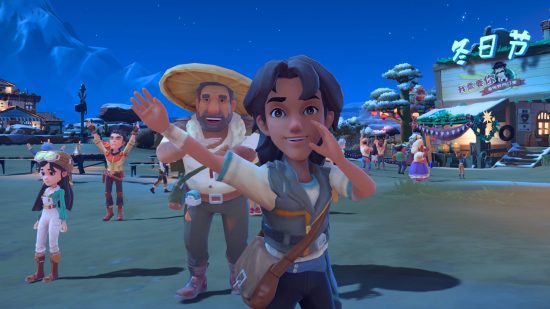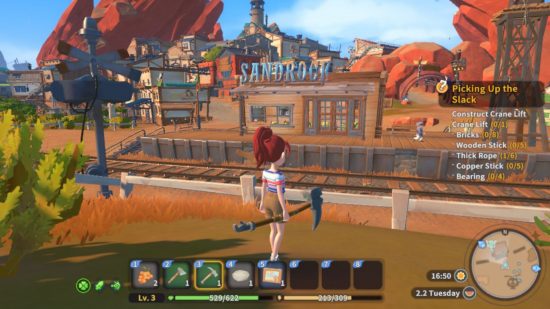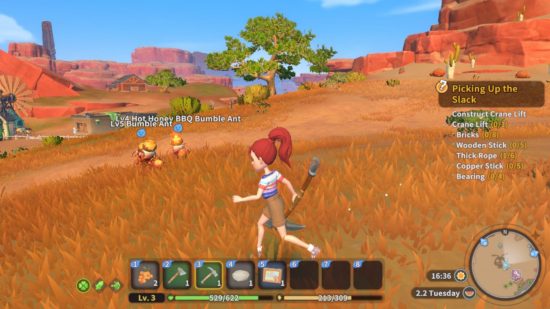My Time at Sandrock made its Nintendo Switch debut last year after an early access period on PC, but it didn’t quite meet the expectations of eager players. Many arguments popped off on Reddit threads where those who play on PC refused to believe performance could be bad on a different platform, but review scores speak for themselves.
I had the chance to review My Time at Sandrock, and I echo the sentiments of other scores. However – the team behind My Time at Portia and its spiritual successor, Sandrock, is aiming to fix up the game and give us a much better experience. I talked with Xu Zhi, director of both Portia and Sandrock, about the plans for the future, and what has already been done to help the game.
Let’s start at the beginning. I asked how the general response was to My Time a Sandrock releasing on Switch – though I did note that sometimes we writers can get carried away and spruce things up to make a read more interesting – though there are a lot of valid concerns surrounding the game.
Zhi replied that player feedback includes positive and negative aspects, and a lot of it is objective. The positives relate to the game’s story, the world, and the diverse range of characters that populate the city. It’s true that players do find themselves engrossed in the storylines and yearning to interact with the characters more. This, she says, is incredibly gratifying.
She then goes on to note that there are indeed negative aspects, relating to the deficiency of previous efforts – namely, how the game runs on the Switch. “This is primarily evident in sporadic popping issues, performance lag, prolonged UI menu loading times, and FPS drops during the mid-to-late stages of the game. These issues were present in the earliest versions released, negatively impacting the gameplay experience for the players who initially supported us,” Zhi says.
The studio behind the My Time games, Pathea, has already produced several updates for Sandrock to address issues and resolve most of the lag and pop-in issues. The overall frame rate has had a noticeable improvement, too.
My Time at Portia, at release, also had issues with performance. I asked if this had any bearing on Sandrock and its development, to which Xu Zhi was quick to note that the port of Portia wasn’t done in-house, and so their insight into any challenges was limited. The team did, however, take note of the long load times in Portia, and made sure to focus on that when it came to Sandrock.
I then went on to ask what was it that went ‘wrong’ with the performance on Switch, and was there any problems that you faced in particular. Xu Zhi notes that the biggest challenge lay in the limited memory of the Nintendo Switch. The game was originally a PC title, meant to run on systems with at least 8GB of RAM. “When porting the game to the Switch, we had to compress the content to fit within the Switch’s constraints of 2-3GB. Our goal is to avoid cutting game content to maintain a consistent player experience across different platforms.”
She explains that insufficient memory capacity causes most of the issues, as more memory could mitigate problems with graphics and overall performance – but obviously, the Switch is limited in that regard.
Pathea decided to handle the Switch port of My Time at Sandrock in-house. I wonder if this had any impact – both positive and negative. Xu Zhi mentions that it’s known that porting to Switch is a challenge, but the team found it harder than they imagined… but, it proved beneficial for their growth. Future games won’t pose the same issues, as now they have the know-how.
A concern of the community was that My Time at Portia remained incomplete before Pathea moved on to Sandrock. Setting up a Kickstarter for the second game as early as possible was necessary to garner attention and get people excited, but did this affect any new content or updates that were due to come to My Time at Portia?
The team has given players an outline of updates planned for 2024. “We intend to release a quarterly free update, accessible across all platforms, [however], due to a longer Switch review process, the Switch version will be delayed compared to other platforms, at least in the first half of this year”. As development goes on, the team expects to achieve a simultaneous release across all platforms, including some paid DLC.
A recent, and very hefty, update came to Sandrock on the Switch, with more on the way to bring in elements from the PC version of the game including babies, dungeons, and side quests. What’s next on the cards for My Time at Sandrock on Switch, and what’s the priority?
Moving forward, the developer’s commitment is to further enhance the FPS, resolve slow UI loading, and ensure an overall better visual experience. Xu Zhi notes that in the current version, “the shadow distance is too close, causing shadows to refresh continuously about 30 meters ahead while the player is running, which breaks immersion”. The team will attempt to address this in the next update, by extending the refresh distance.
“Of course, the next version will also incorporate all content from the PC Christmas update (‘New Year, Better Me’ version), including the Roller Coaster in Catori World. Players can enjoy riding roller coasters and merry-go-rounds with their in-game partners, adding a cool new feature”- who doesn’t love a good funfair?

Looking even further ahead, I asked what we can look forward to in the future of Sandrock or the My Time series on Switch, and if there are any events or expansions planned, or if there’s a new game on the horizon.
The team is excited about creating more My Time games in the future – and recognizes that the Switch is the ideal platform for the series. “The lessons learned from this experience will undoubtedly enhance the performance of future My Time [games on] Switch. Moreover, we’re looking forward to sharing plans for bringing some of our other studio games to the Switch platform later this year”.
Zhi says that the current version is significantly better than the previous one – and I have to agree. While there’s still a lot of work to be done, the game looks and feels a lot smoother in terms of playing it. There’s still quite a bit of scenery popping in, but you can run around and swing your tools without stuttering issues. The menus are already a little quicker, too. While it may not compare to flawless entries in the Switch library, I do feel like I can recommend the game now, and will likely jump into it myself.
Thank you very much to Xu Zhi for answering my questions, and to the team at Renaissance PR for setting up this opportunity. If you’re looking for some good farm games to play, we can recommend some. We can also point out which bad games on Switch to stay away from, too.


